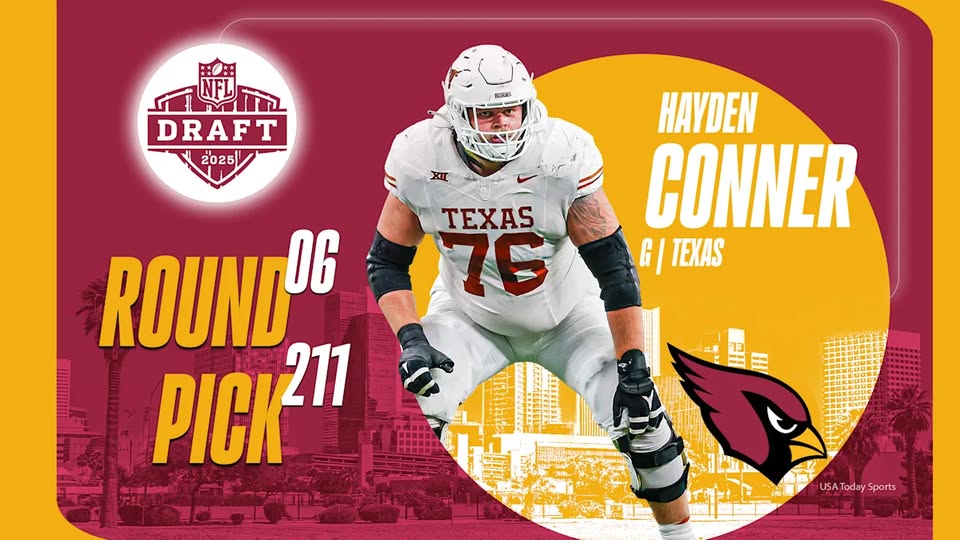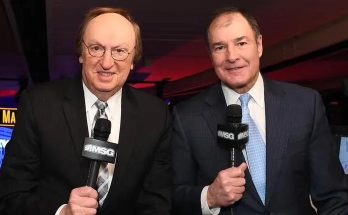The 2025 NFL Draft was crucial for the Arizona Cardinals as they looked to solidify their offensive core around franchise quarterback Kyler Murray and continue the reconstruction process under general manager Monti Ossenfort and head coach Jonathan Gannon. Among their series of selections, one that stands out for its potential value and long-term benefit came when the Cardinals selected offensive lineman Hayden Conner out of Texas.
Conner’s addition, though not flashy, is one rooted in practicality and foresight. Here’s a breakdown of the selection, how it fits into Arizona’s long-term plans, and a comprehensive grade for the move.
Who is Hayden Conner?
Hayden Conner, a towering 6-foot-6, 320-pound offensive lineman from the University of Texas, brings physical maturity, high football IQ, and position versatility. Over his collegiate career, Conner primarily played at guard but showcased his ability to slide across the interior and even step in at tackle in certain packages. He was part of one of the most dominant offensive lines in the country during the Longhorns’ 2023 and 2024 campaigns under head coach Steve Sarkisian.
What makes Conner especially attractive is his blend of size, anchor strength, and nimble feet for a player of his frame. While he doesn’t boast the raw athleticism of some first-round prospects, he is technically sound and rarely loses in one-on-one matchups. His hands are active, his leverage is excellent, and he possesses a strong understanding of blitz pickups and stunts, traits that NFL coaches covet.
Cardinals’ Offensive Line Status
Arizona’s offensive line has been an ongoing area of concern, especially since the departure of some key veterans over the last few years. Injuries, inconsistency, and a general lack of depth have left Kyler Murray scrambling far too often. In 2024, the team allowed 48 sacks (8th-most in the NFL), and much of that pressure came from the interior.
While Paris Johnson Jr., the 2023 first-rounder, looks like a future Pro Bowler at tackle, the interior line has been a turnstile of underperforming veterans and developmental projects. Will Hernandez has been solid at guard but is nearing the end of his contract, and center Hjalte Froholdt struggled in pass protection throughout last season.
Conner fills a need at guard immediately and could even transition to center if needed—something he was cross-trained in during pre-draft workouts. His scheme versatility and proven experience at a high level of college football (including multiple College Football Playoff appearances) make him a logical fit for what Arizona is building.
The Pick: Round and Value Assessment
The Cardinals selected Hayden Conner in the fourth round—a sweet spot for grabbing dependable offensive linemen who may not be elite athletes but project as long-term NFL starters. While Conner didn’t carry the same media hype as first-rounders like Oregon’s Jackson Powers-Johnson or Georgia’s Amarius Mims, scouts across the league consistently praised his reliability and “plug-and-play” potential.
Many draft analysts had Conner ranked as a top-10 guard in the class, with some projecting him in the late third or early fourth round. By selecting him where they did, Arizona managed to extract maximum value without reaching.
Value Grade: A-
Strengths of Hayden Conner
1. Size and Anchor
Conner has prototypical NFL guard size and brings a wide, powerful frame that neutralizes interior bull rushers. He sets a firm anchor and is rarely pushed backward. His mass and grip strength allow him to latch onto defenders and finish plays.
2. Football IQ and Technique
Conner understands leverage and consistently keeps his pad level low. His technique is crisp, and he reacts well to twists and delayed blitzes. He rarely gets caught flat-footed, a testament to his pre-snap recognition and coaching at Texas.
3. Run Blocking
As a run blocker, Conner thrives in power schemes. He generates movement off the snap, particularly on down blocks and double teams. He’s not just a wall; he moves defenders and opens lanes—something Arizona sorely lacked in short-yardage situations last year.
4. Durability and Experience
A multi-year starter in a physical conference like the Big 12 (and later the SEC), Conner stayed healthy throughout his college career and logged over 2,500 snaps. That kind of durability matters when projecting offensive line success at the next level.
Areas for Improvement
1. Lateral Agility
Conner’s foot speed in space is adequate but not elite. He can struggle when asked to pull and hit moving targets at the second level. In an outside zone-heavy scheme, he may not be an ideal fit.
2. Finishing Plays
While technically sound, Conner sometimes stops his feet after contact, relying on size rather than drive to finish blocks. NFL defensive linemen will capitalize on any pause in effort.
3. Pass Pro Consistency Against Quick Interior Rushers
Though he rarely loses to power, quicker 3-techniques with twitch and counters have occasionally gotten inside of him. Developing a more explosive first step and punch timing will help mitigate this concern.
Fit Within the Cardinals’ Offensive Scheme
The Cardinals’ offense is expected to evolve in 2025 with a greater emphasis on play-action and downhill running. Offensive coordinator Drew Petzing has made it clear that the team wants to establish a physical identity up front. Hayden Conner fits this mold perfectly.
He profiles as a guard who can start Day 1 at left or right guard and provide a physical presence that Arizona has lacked. His familiarity with gap and power schemes from his time at Texas aligns well with what Petzing is expected to implement. Conner’s ability to communicate protections and adjust at the line of scrimmage also aids Kyler Murray, whose improvisational style sometimes stresses offensive line cohesion.
NFL Comparison: Ben Powers (Denver Broncos)
Hayden Conner’s style and build are reminiscent of current Broncos guard Ben Powers. Both are big-bodied, technically sound guards who may not wow in combine drills but win with consistency, awareness, and toughness. Powers was a fourth-round pick who developed into a reliable starter—and Conner could very well follow the same trajectory.
Projection: Short-Term and Long-Term Outlook
Short-Term:
Conner will likely compete for a starting job immediately. With Arizona lacking stability at both guard spots, his odds of cracking the starting five are high. At worst, he begins as a swing interior lineman who can rotate in and cover multiple roles due to injury or ineffectiveness.
Long-Term:
Hayden Conner has the potential to become a long-term starter, especially if paired next to someone like Paris Johnson Jr. in future line combinations. He may never be a Pro Bowl mainstay, but he could absolutely become a 10-year starter, which is tremendous value in the fourth round.
Draft Grade: B+ Overall
Why Not an “A”?
While this is a rock-solid pick, the only thing keeping it from an A-grade is the ceiling. Conner’s lack of elite athleticism limits his upside. He’s a “safe” pick, not necessarily a game-changer. In other words, he’s more foundational than transformational.
Still, there’s real value in finding plug-and-play linemen on Day 3 who can anchor your line for years, and the Cardinals did just that.
Fan and Media Reaction
The pick was met with quiet optimism. Cardinals fans who follow the draft closely recognized the need to address the offensive line and appreciated the selection of a durable, high-floor player. NFL Network analyst Daniel Jeremiah noted during the broadcast, “This is the kind of pick that doesn’t make headlines but helps you win games in December.” ESPN’s Louis Riddick also chimed in, saying Conner “plays with a pro’s mindset and will bring leadership to that locker room.”
Final Thoughts
The Arizona Cardinals took a measured, intelligent approach by selecting Hayden Conner. While fans may have hoped for a more dynamic skill-position player, protecting Kyler Murray and improving the offensive trench play should remain the team’s top priority. Conner isn’t a flashy pick, but he’s a foundational one—and one that could pay dividends for years.



